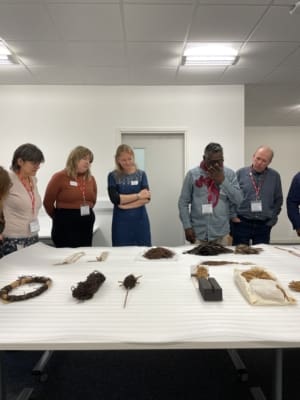People and Plants Workshop 2: Western Australia (2)
Nicola Froggatt (Research Manager, the National Trust), 3rd January 2023.
This blogpost reflects on the second in-person workshop of the People and Plants project which took place on 7th November 2022 in Edinburgh. It brought together speakers from the Australian Tropical Herbarium, National Museums Scotland, Ngarluma Yindjibarndi Foundation and University of Western Australia. We collectively focused on a group of historic Ngarluma and Yindjibarndi biocultural material now held at National Museums Scotland. The Museum holds dozens of Aboriginal objects sold and given to it in the 1890s by Dr. Emile Clement, a collector who was managing gold mines in Western Australia. Clement was the most prolific known contributor to British and Irish collections of so-called ‘ethnographic’ objects from Western Australia during the colonial period, and his reflections once dominated how western museums acquired and interpreted Aboriginal material. Now, however, the collection demonstrates the potential of indigenous ethnobotanical material for knowledge-sharing work.

Knowledge through Country
A common thread emerged throughout the day’s discussions: the centrality of Country in better understanding these Ngarluma and Yindjibarndi objects. ‘Country’ is ‘the term often used by Aboriginal peoples to describe the lands, waterways and seas to which they are connected. The term contains complex ideas about law, place, custom, language, spiritual belief, cultural practice, material sustenance, family and identity’.[1] Ngarluma and Yindjibarndi Country, in the Pilbara region of Western Australia, encompasses a rich and diverse landscape of coastline, rivers, mountains and more. Clement sold or gave over 1,600 Aboriginal objects to European museums, of which the overwhelming majority came from the Pilbara. Ali Clark (National Museums Scotland) and Alistair Paterson (University of Western Australia) reflected that for many European museums the region effectively became a proxy for Australia, downplaying the diversity of the continent’s hundreds of Aboriginal cultural groups. Speaking with Kate Oosterhof, senior Ngarluma woman Kerry Churnside and senior Yindjibarndi man Kevin Guiness (all Ngarluma Yindjibarndi Foundation) flagged how problematic it is for Aboriginal people to continue finding their distinctive cultural identities carelessly lumped together.
We saw how objects are embedded with information that inherently challenges the ‘flattening’ of diverse indigenous cultural knowledges within colonial worldviews. For example, when read with appropriate cultural expertise, Kevin explained, a wooden spear-thrower’s markings can be identified as specifically Ngarluma or Yindjibarndi. Clement’s notes on this point are lacking, but for too long they were the major lens through which curators understood and interpreted the items. Today, working across different collections and ‘types’ of museum connects stories and reveals relationships between objects that have too often been discussed in isolation. We considered a hand fishing net made of spinifex grass cord, and its potential usage alongside botanical fish poison such as an example held at Kew Gardens in London. Such stories of use challenge traditional western divisions between ‘plant specimen’ and ‘ethnographic artefact’.
Objects as Connectors
Kerry powerfully discussed how Ngarluma and Yindjibarndi biocultural objects sit within a wider holistic system of being. She introduced the Galharra (skin group) system, within which everyone is connected and understood to carry different roles and responsibilities. People, plants, animals: all sit in relationship to the land and each other under a system written into Country back ‘when the world was soft’. I was struck by the need to appreciate the Galharra system’s significance when thinking about Ngarluma and Yindjibarndi material culture.
Objects are connectors of many different stories and meanings, and this proved especially striking given that many Aboriginal objects are multifunctional. These diverse functions may not be recognised in museum documentation. Kevin returned to a spear-thrower, drawing our attention to notches carved along one side. These marks, he explained, reveal something not documented in the museum record. Their significance starts to emerge when placed alongside an unassuming-looking pick-saw, which can be brushed across the notches to make music. Tool, weapon, musical instrument: this spear-thrower is all these and more.
Working Well
Our conversations also turned to how indigenous bio-cultural knowledge and objects were and are being used by non-indigenous researchers. Gerry Turpin (Australian Tropical Herbarium) observed that all the world’s biodiversity hotspots have been managed in some way by indigenous peoples. How can we ensure that indigenous bio-cultural knowledge benefits these communities? How can western researchers and practitioners break cycles of biopiracy, the taking of plant knowledge without negotiation with and consent from those who nurtured and sustained it? These questions are as pertinent to museum practitioners as they are to commercial enterprises like the bush-tucker and medicine industries.

Kevin and Kerry highlighted a further ethical dimension stemming from the irrevocable link between the objects in Edinburgh and their Ngarluma and Yindjibarndi Country. No matter how far it travels, Kevin noted, a boomerang remains tied with its homeland and the tree it came from. Objects can be homesick, so visiting them is a hard but important thing for Traditional Custodians to do. It is therefore important to respect the emotional and cultural burdens that Aboriginal knowledge holders may be carrying to make research collaborations between Britain and Australia possible. When done respectfully, the knowledge gained through these relationships has the potential to transform how museums can understand and communicate the rich knowledge embedded within ethnobotanical collections.